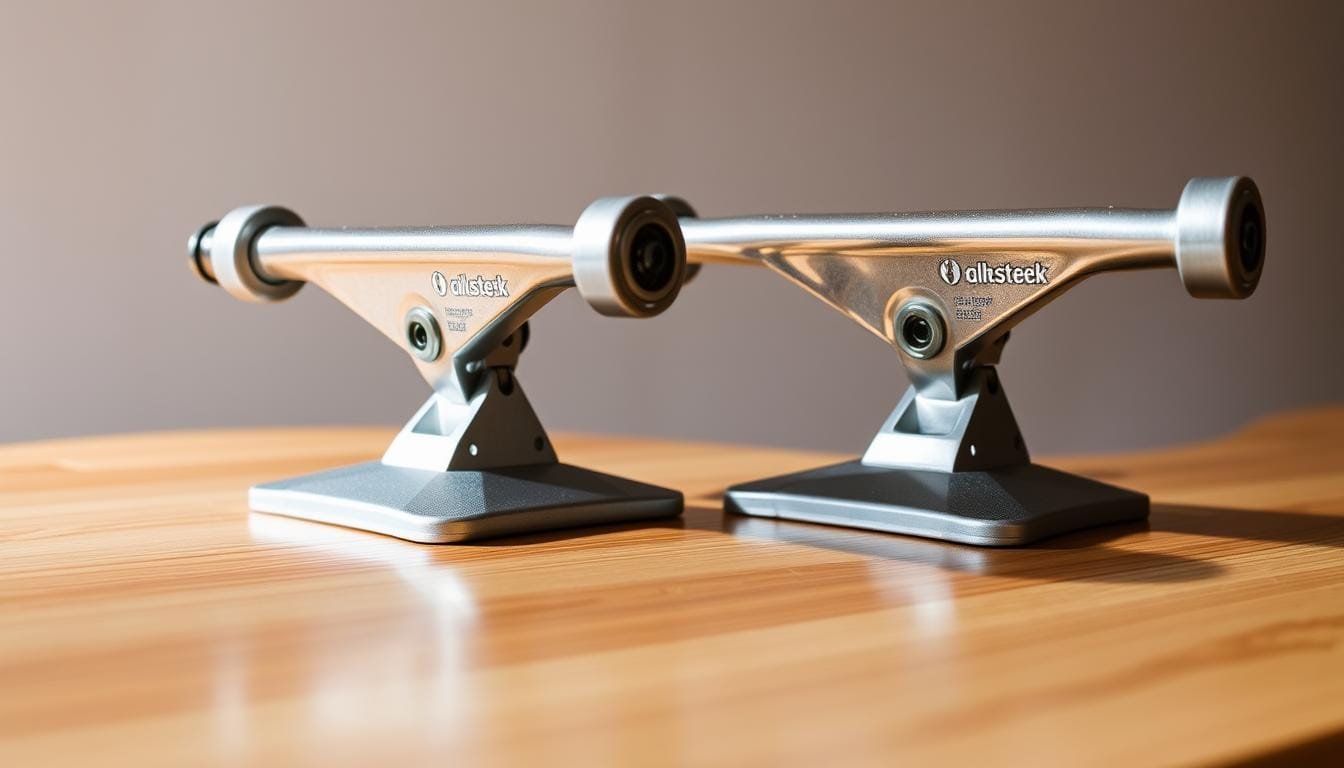Choosing the right setup for your skateboard is important. Truck width plays a big part in this. We’ll look at the pros and cons of wider trucks to see if they fit your cruising style.
Key Takeaways
- Wider trucks offer increased stability, especially at higher speeds.
- The added width can provide a smoother ride, ideal for rugged surfaces.
- However, wider trucks might decrease maneuverability and add extra weight.
- Matching truck width to deck width is crucial for optimal performance.
- Consider how your cruising style aligns with the benefits of wider trucks.
Introduction to Truck Width and Cruising
Skateboarding trucks are key for stability and how your board performs. Wider trucks are great for longboards and cruisers. They help make cruising more fun.
Knowing how truck width changes your ride is key for skateboarders. Wider trucks make for a stable, smooth ride. This is perfect for cruising at a relaxed pace.
Skateboarding trucks come in types like cast, forged, and precision. Each type changes how your skateboard feels:
- Cast Trucks: Great for longboards, these are made by pouring melted metal into a mold. They’re affordable but might not be as tough as others.
- Forged Trucks: Made by pressing metal into a shape, these are stronger than cast trucks. They’re made using pressure or heat.
- Precision Trucks: These are made using CNC machines from metal blocks. They are very strong and precise because of how the metal is arranged.
The angle of the truck’s baseplate also matters for how it performs. A 50-degree baseplate is good for speeds under 35 mph. For speeds over 35 mph, you might want a 40-degree baseplate. The width of your trucks compared to your deck width matters a lot for how stable and controlled your ride feels.
| Deck Width | Recommended Truck Width |
|---|---|
| 9.25″-10″ | 170mm-205mm (approximately 9.5″-10.5″) |
| 8.75″-9.25″ | 125mm-150mm (approximately 8.5″-9″) |
Longboard trucks usually are between 150mm and 180mm wide. A 180mm truck is about 10 inches. Reverse kingpin trucks are known for a responsive, stable ride. This really helps when cruising.
To wrap up, knowing about skateboard truck sizes and width is key for a good cruise. Picking the right trucks means looking at their type, baseplate angle, and how the width matches your deck. This info helps make your ride stable and fun for cruising.
The Benefits of Wider Trucks for Cruising
Wider skateboard trucks offer great benefits for cruising. They make your ride stable and spread your weight well. Usually, these trucks are 5 to 10 inches wide. They match skateboard decks perfectly, boosting performance and trustworthiness.
Stability is a huge plus with wider trucks. They cut down on wobbles, helping you stay balanced, even on long rides. This is really helpful on different types of ground, giving you a smoother journey.
Also, wider trucks fit bigger wheels well. Big wheels lower the chance of wheelbite, which happens during tight turns when wheels rub the deck. This means you get a ride that’s both safer and more comfortable.
Besides stability, wider trucks spread your weight evenly on the board. This balance is key for good control and a better cruising experience. For example, reverse kingpin trucks are great for turns and improve your carving skills.
So, if a smooth and steady ride matters to you, the advantages of wider skateboard trucks are obvious. Choosing the right width, for tricks or cruising, seriously upgrades your skateboarding.
Potential Drawbacks of Wider Trucks
While wider trucks offer some remarkable benefits for cruising, they’re not without their drawbacks. Wider trucks mean less agility. This makes quick turns or tight spots hard to handle. It’s tough for skaters who perform tricks or navigate crowded streets.
Another issue is their heavier weight. Wider trucks need more material, like aluminum or steel. This adds weight to your skate setup. More weight can make you tired faster. It also makes your board less responsive and harder to control.
There can be problems with matching deck sizes too. Trucks should be about 0.5 inches narrower than the deck for best stability. But finding the right fit is hard, especially with unique decks. A bad match can make your ride unbalanced and less fun.
Changing parts on long skateboard trucks can overwhelm new riders too. Even with lots of customizable parts, it may not be easy for everyone. Beginners might find choosing the right setup complicated.
To sum up, knowing these drawbacks is key to making a good choice. Weighing these cons against the pros can help you pick what’s best for you. It’s about what suits your needs and how you like to ride.
Wider Trucks vs. Standard Trucks: A Comparison
Comparing skateboard trucks shows big differences, especially in performance and styles. Standard trucks, usually around 2 inches wide, are great for skaters who like quick, sharp turns. They’re best for skills like roller derby, figure skating, and street skateboarding.
Wide trucks, which are between 2.5 to 3 inches, give more stability. This is helpful for skatepark and aggressive skating. It helps you land tricks safely. Skaters with big feet might choose 3-inch trucks for better grinding. Those with smaller feet may go for 2.5-inch trucks.
It’s also important to understand truck height. Low trucks work best with wheels under 55mm to avoid wheel bite. This setup is good for doing technical tricks.
Meanwhile, mid or high trucks fit larger wheels better. This makes for smoother cruising and carving. Choosing between standard and wider trucks may also hinge on compatibility with other parts. This includes skate plates and manufacturers’ specs. Each brand might have different truck heights and designs. This means customization is crucial for the best performance. For more details, visit this comprehensive guide on truck differences.
Ideal Truck Width for Cruising
When looking for the best truck width for cruising, think about your deck size, how you skate, and what feels right for you. The perfect truck width should match up with your deck width. You can go up or down by 0.25 inches. For instance, if you have an 8.25-inch deck, you can use trucks that are 8, 8.25 (just right), or 8.5 inches wide. This fit gives you a stable and smooth ride. It helps avoid problems like wheelbite and feeling unsteady.
Deciding on wider or narrower trucks depends on how you skate. Wider trucks are more stable, which is great for ramp skating. But, if you like doing flip tricks on the street, narrower trucks are better. Make sure to measure your trucks right, as they can be listed by hanger width or axle width. This often makes choosing the right size tricky.
| Deck Width | Recommended Truck Width |
|---|---|
| 6.5″-7.25″ | 6″-7.25″ |
| 7.25″-7.75″ | 7.5″ |
| 7.75″-8.25″ | 7.75″ |
| 8.0″-8.5″ | 8.0″ |
| 8.5″-9.0″ | 8.5″ |
| 9.0″-10.0″ | 9.0″ |
| 10.0″+ | 10.0″ |
A good rule for setting up your board is to keep the axle nuts of your trucks close to the edge of your deck. They should be less than a quarter inch away. This position keeps your ride balanced and stable. It also stops your shoes from hitting the wheels.
There are also different types of kingpins. Most skateboards have standard kingpins. But, cruisers and longboards usually have reverse kingpins. This design helps with turning and clearance. Most trucks are designed to be high profile, unless otherwise noted.
Whether you’re just starting and prefer low trucks for better balance, or you’re experienced and want high trucks for more turn and tricks, the best truck width for cruising changes as you grow in skateboarding.
Tips for Choosing the Right Trucks for You
Choosing the right skateboard trucks is key to a great riding experience. Here are some tips to help you pick the best trucks. These tips are meant for assembly and finding the ideal trucks for cruising.
Match the truck axle width with your skateboard deck for better stability. Truck axle widths vary from 6″ to 10″ and fit corresponding deck sizes.
| Truck Axle Size | Deck Width |
|---|---|
| 6″-7.25″ | 6.5″-7.25″ |
| 7.5″ | 7.25″-7.5″ |
| 7.75″ | 7.5″-8″ |
| 8.0″ | 8″-8.5″ |
| 8.5″ | 8.5″-9″ |
| 9.0″ | 9″-10″ |
| 10.0″ | 10″+ |
Consider the truck profile as it affects your performance. Low trucks work best with 50-53mm wheels for street skating. Mid trucks are good with 53-56mm wheels and are versatile. High trucks fit 56mm+ wheels, perfect for cruising and carving.
Choose trucks that match your riding style and preferences. For lighter, more responsive trucks, check out models with hollow kingpins and axles. Thunder Hollow Lights or Independent Forged Titanium are good picks. They’re strong yet light.
Always check your trucks for wear and tear signs. Look for cracks, warped baseplates, or bent axles. Replace them when needed for safe and smooth rides.
Conclusion: Making the Right Choice for Your Ride
Finding the right skateboard trucks is key for a great ride, whether you’re cruising or skating in the park. You should know the differences between cast, precision, and forged trucks. Also, picking the right width and height is important for how well you perform and stay stable. The width of the trucks should match your deck to keep you balanced. The truck’s height and material also affect how you can move and the feel of your ride.
For cruising, go for wider trucks. They’re more stable and work well with longboard decks and cruiser boards. You might want to try different bushings and baseplate angles to get the best turning and control. Brands like Independent, Thunder, and Paris make high-quality trucks for different needs, including being lightweight or extra tough.
To wrap it up, choosing the right trucks means knowing your skating style and where you’ll skate. Spend time getting your skateboard setup just right for you. This way, you’ll have a smoother, more fun ride. The best trucks for cruising will meet your specific needs and help you skate confidently.

I’m John Peterson, a passionate skater, blogger, and lifelong enthusiast. I’ve been skating for over 9 years and have gone on to write a blog dedicated to the sport of skating and its culture. Through my blog, I strive to share my knowledge and experience of the sport with all who are interested. From beginner tips, tricks, and equipment reviews to interviews and event coverage, I cover it all. So read my blog as I explore the wonderful world of skating!

